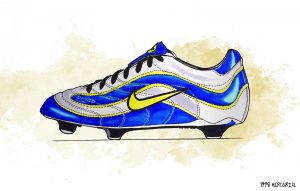 In 1996, Nike partnered with the world’s most decorated international side, the Brasilian National Team, and began its mission to create a boot worthy of their caliber of play. Ronaldo, the squad’s young striker, was chosen as the muse. On the pitch, he was patient — stalking and waiting for the right moment. Then, when opportunity arose, he’d strike, accelerating to the ball with unrelenting velocity. With the goal in his sights, Ronaldo would change in nature. He was, in short, mercurial.
In 1996, Nike partnered with the world’s most decorated international side, the Brasilian National Team, and began its mission to create a boot worthy of their caliber of play. Ronaldo, the squad’s young striker, was chosen as the muse. On the pitch, he was patient — stalking and waiting for the right moment. Then, when opportunity arose, he’d strike, accelerating to the ball with unrelenting velocity. With the goal in his sights, Ronaldo would change in nature. He was, in short, mercurial.
To craft a boot suited to Ronaldo’s explosive style, Nike designers looked to the track. Early concepts included a dissembled track spike married to a Nike Tiempo upper, which illustrated the objective of unmatched weight reduction in a football boot. To meet the challenge, the team of designers bucked longstanding trends by eschewing kangaroo leather and employing a synthetic kangaroo replacement, KNG-100. The second major breakthrough was reducing plate thickness from the industry-standard 3 mm to a game-changing 1.75 mm. “Everything was shocking at the time. The look, the materials, people didn’t know what to think. It was a truly exciting moment,” Luca Bolpagni from Nike’s Product Creation Centre in Montebelluna, Italy, said of the innovations.
Ronaldo scored the first goal, a brilliant half-volley, in the debut Mercurial on June 16, 1998. Almost 20 years later, thousands of other goals have been netted in the silo, including casual five-a-side strikes and tournament-winning penalties. The boot itself kept evolving too, always to meet the needs of contemporary mercurial athletes and giving both new innovative stance and aesthetic styling to football as a whole.
THE 1998 NIKE MERCURIAL: THE FIRST BOOT BUILT FOR SPEED
The genesis: Initially known as Tiempo Ultra Light and the Ronaldo Ultra Speed, the first Nike Mercurial was engineered with Ronaldo’s startling velocity in mind.
The tech: The KNG-100 upper behaved like leather but didn’t absorb water the way natural fabrics did and was thinner and lighter than traditional leather — shattering the stigma of synthetics and changing how football footwear was made. On it, a sticky coating sourced from the chassis of racing motorcycles offered ultimate ball control.
The look: It made an impact in blue and yellow on Ronaldo’s feet.
THE 2000 NIKE MATCH MERCURIAL: FAST GETS FASTER
The genesis: For the second generation, the boot’s development became part of Nike’s Alpha Project — a series of footwear including the Mercurial R9, Air Zoom Italia, Match Mercurial and Air Zoom Mercurial (a rare piece incorporating full-length Nike Zoom Air cushioning) symbolized by five dots and emblematic of excellence in performance — and focused on further reducing the weight of a boot.
The tech: Weighing just 230 grams, it proved that Nike’s experiment with lightweight football boots didn’t end with the original Nike Mercurial.
The look: While it retained the same last as the first model, it was given its own distinct aesthetic, most notably on Ronaldo’s signature Match Mercurial R9, where the KNG-100 was dressed in a metallic copper that faded to black toward the toe panel.
THE 2002 NIKE MERCURIAL VAPOR: FROM THE ROAD TO THE PITCH
The genesis: If the initial idea of the Mercurial line was to build a track spike for the pitch, the third iteration was created to sustain a 90-minute sprint and deliver the perfect foot-to-ground feel for fast players.
The tech: In order to remove excess weight, everything from glue to stitching thread was weighed. A new anatomical last created around the natural shape of the foot relieved pressure and brought the player closer to the boot’s plate. The innovative fit reduced weight and added comfort, and, in a testament to the Mercurial’s DNA, increased speed. American stars Mia Hamm (who led the U.S. Women’s team to victory in 2003 and a gold in 2004) and Brandi Chastain wore this, and their insights led to the forthcoming 2003 Nike Women’s Mercurial Vapor, which was built to the exact specifications of the female foot.
The look: All speed — evidenced by lines inspired by the fastest production cars of the era.
THE 2004 NIKE MERCURIAL VAPOR II: A NEW STAR IS BORN
The genesis: Refinements to comfort were required to realize the goal of a perfect foot-to-ground feel.
The tech: Modifications to fit included an enlarged heel tab for extra ankle cushioning.
The look: The Team Red edition indicated that bold color was still part of the Mercurial Vapor’s aesthetic, but it was Ronaldo’s signature gold and black for the Mercurial Vapor II R9 that is most remembered. The audacious design stood out on the feet of emerging star Cristiano Ronaldo in a fluid passing of the torch.
THE 2006 NIKE MERCURIAL VAPOR III: Form fitting
The genesis: The key for the Mercurial Vapor III was finding a way to get closer to the foot without compromising comfort throughout an entire match.
The tech: Teijin microfiber that was engineered to conform and adjust to the foot’s shape was introduced to the upper. Increased padding on the exposed, form-fitting heel cup evolved the fit, which was completed by an anatomically contoured speed last and a carbon fiber heel wrap to distribute heel-strike impact. A two-piece plate with direct injection studs enabled multidirectional traction and acceleration.
The look: Cristiano Ronaldo wore it in a bold Cactus colorway. Brasilian Ronaldo celebrated his all-time tournament scoring record with a limited-edition version of the Mercurial Vapor III R9, and signaled a decade of Mercurial speed with a 10th-anniversary edition (released in 2007) that brought the distinctive color scheme of the original Mercurial to the carbon fiber-aided Mercurial Vapor III platform.
THE 2008 NIKE MERCURIAL VAPOR SL: something outrageous
The genesis: When footwear designer Mark Parker become CEO of Nike in January 2006, he challenged every design team to create something outrageous with no design limitations, inviting a re-imagining of innovation in performance footwear.
The tech: Reacting to this challenge, Nike Football super-charged the Mercurial’s lightweight speed concept by constructing the latest silhouette entirely out of carbon fiber. It weighed in at just 185 grams. With the upper crafted in Italy, the plate engineered in Germany, and the outsole built in South Korea, the Mercurial SL was a product of the global game.
The look: Unmistakable carbon upper? Say no more.
THE 2008 NIKE MERCURIAL VAPOR IV: bold moves
The genesis: Offering an uninterrupted shooting surface and introducing the look of an aerodynamic sprint spike to the pitch were the priorities.
The tech: The Teijin upper covered the laces and a new internal chassis made of glass fiber enabled instant acceleration similar to the propulsive snap of a track spike.
The look: The shoe’s inherent speed was augmented by Orange Peel and Citron, which were some of the boldest colors ever seen on a pitch. And in Mercurial Vapor Rosa, the shoe put a final flamboyant stake in the heart of black boot purists.
THE 2009 NIKE MERCURIAL VAPOR SUPERFLY: FIT PERFECTED
The genesis: What does the athlete want? How can a boot feel like less but deliver everything? The answers yielded the lightest, fastest Nike boot at the time.
The tech: A composite upper package using an ultra-thin Teijin skin exterior and Nike Flywire (engineered for lightweight support and fresh off debut in Beijing) locked the foot in place. This finely tuned shell ensured the best possible fit and an uncompromised feel on the ball. New lightweight traction cleats and a carbon fiber chassis shaved precious weight from the boot, and a seven-layer carbon outsole delivered maximum resilience and flexibility. Working in harmony, the upper and sole of the boot allowed athletes to accelerate and react quicker.
The look: The visible Flywire gave the Nike Mercurial Vapor Superfly a high-tech aesthetic that championed the boot’s components.
THE 2010 NIKE MERCURIAL VAPOR SUPERFLY II: CAT-LIKE REFLEXES
The genesis: Inspired by the cheetah, the Mercurial Superfly II turned the question of speed into a question of traction.
The tech: Influenced by insight from Cristiano Ronaldo, the Mercurial Superfly II incorporated Nike SENSE technology (innovative studs that extended and retracted by millimeters based on pressure and ground conditions) providing a base for optimum speed and stability in all directions. For the 2010 summer in South Africa, the Mercurial Vapor Superfly II was also given an Elite Series makeup, where premium speed was augmented by reduced weight achieved via a carbon fiber plate.
The look: The Elite Series makeup boasted a Mach Violet and Total Orange colorway, a scheme chosen after an intense investigation on what colors stimulate peripheral vision in game conditions.
THE 2011 NIKE MERCURIAL VAPOR SUPERFLY III: firmest footing
The genesis: The third incarnation of the Nike Mercurial Vapor Superfly aimed to maximize a player’s every chance on pitch by eliminating small stumbles and slips that can be exploited by the opposition.
The tech: Toe-off traction reduced the risk of slipping while a tri-blade configuration maximized speed during directional changes. The refined composite upper was more streamlined than ever thanks to a carbon fiber chassis.
The look: Bold color placement at the rear of the boot and overall color combination expanded on the Elite Series’ concept of visual acuity.
THE 2012 NIKE MERCURIAL VAPOR VIII: barely there
The genesis: For this addition to the lineage, considerations of acceleration to the ball and touch at high speed were primary.
The tech: A new flexible fiberglass outsole employed a new traction system of buttresses on the studs that ensured fast-in, fast-out ground penetration, while a high-pressure point central stud was engineered to boost acceleration. The contoured last followed the natural shape of the foot, and incorporated a softer heel to minimize distraction. A lowered toe and more sculpted arch changed the fit of the boot around the foot, and the Teijin microfiber upper’s suede-like finish increased touch and control by providing a barefoot feel.
The look: The unmistakable Mango launch colorway further caught attention.
THE 2013 NIKE MERCURIAL VAPOR IX: retooled for ultimate control
The genesis: The ninth iteration of the Mercurial Vapor set sight on complete control.
The tech: The upper featured a combination of All Conditions Control (ACC) for consistent feel in wet or dry conditions and Speed Control with a texture akin to a golf ball, providing equal measures of soft touch and friction against the ball. A lightweight plate with two distinct glass pieces for increased flexibility and twin studs with asymmetrical configuration completed the retooling, offering ultra-responsive acceleration and traction in all directions.
The look: Cristiano Ronaldo’s CR7 edition Mercurial Vapor IX unleashed neon colors accented by a Safari print on the newly textured upper. The CR7 Mercurial Vapor Supernova’s all-over intergalactic print hammered down the explosive, otherworldly speed of the line.
THE 2014 NIKE MERCURIAL SUPERFLY IV: A SLINGSHOT FOR THE FOOT
The genesis: The latest version was designed for the player who is always a step ahead of his marker.
The tech: Through a new three-knit weave, Nike Flyknit technology on the upper put less material between the foot and the ball to enhance touch. The mid-top Dynamic Fit Collar improved the connection between the player and boot. The addition of Brio cables, knitted directly into the upper, locked the foot to the boot’s full-length carbon plate for efficient transfer of power through the ground. Added studs on the boot’s heel increased stability while the track-inspired toe traction integral to the Mercurial’s DNA was vital in providing grip and propulsion.
The look: The Dynamic Fit Collar, which debuted in the Nike Magista, undoubtedly transformed the football boot silhouette. But when it joined the Mercurial line, the new look transferred from pitch informing the HTM Nike Free Flyknit Mercurial SP and, ultimately, kick-starting one of the most significant trends in recent footwear history.
THE 2016 NIKE MERCURIAL SUPERFLY V: four firsts raise the bar again
The genesis: Every component was created to work in concert toward the singular goal of unleashing a player’s full speed potential, creating the ultimate expression of Mercurial.
The tech: Designers eliminated the gap that previously existed underfoot by using a new anatomical plate that mapped the natural contours of the foot. A new vacuum forming process enabled them to engineer a single-layer chassis for the sole plate, which was 40-percent lighter — yet it’s stronger and more responsive — than the carbon fiber plate it replaced. For the first time, finite element analysis (FEA) testing was used to provide scientific data to identify the best traction pattern for the speed-focused player, landing on a data-informed pattern that acted like claws when a player accelerated. Data-informed texture mapping was used for the first time to create a 3D Flyknit “speed rib” texture where raised surfaces provided friction between the upper and ball.
The look: The aesthetic potential of the Mercurial Superfly V is best articulated by Cristiano Ronaldo’s series of special edition colorways. These include the Chapter 5: Cut to Brilliance, which celebrates Ronaldo’s career goal scoring exploits.
The Next Nike Mercurial will be revealed February 7…
 Arunava about Football A look at football & the world through my eyes!
Arunava about Football A look at football & the world through my eyes!



